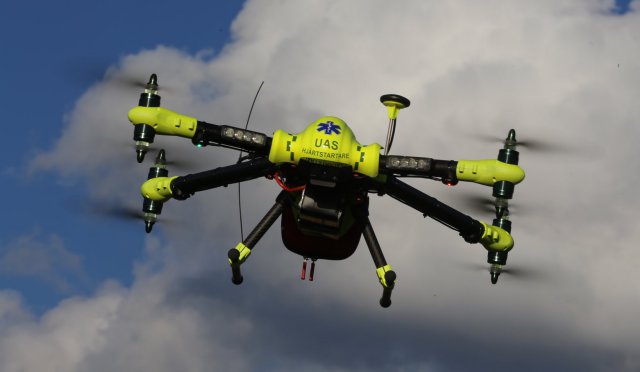
A simulated study found that drones carrying a defibrillator, which could be used by a member of the public, arrived 16 minutes quicker than the emergency services on average, saving precious time.
Jacob Hollenberg, director of the centre for resuscitation science at the Karolinska Institute, Stockholm, who led the study, told the Guardian:
“Cardiac arrest is one of the major killers in the western world. Every minute is crucial; I would say every second is crucial.
“Every minute that passes from collapse to [cardiopulmonary resuscitation] or defibrillation, the chances of survival goes down by 10%. That’s why survival after 10 to 12min is basically zero. There’s a huge difference in using the defibrillator within the first few minutes. Even if you improve the timing of the ambulances in these type of situations, it’s too late – only one in 10 victims survive”.
The 5.7kg (12.5lb) drone was developed by the Swedish Transportation Agency to carry a 763g (1.6lb) automated external defibrillator (AED). The eight-rotor unmanned aerial drone, with a maximum cruising speed of 75km/h (47mph), was housed at a fire station north of Stockholm.
Over a 72-hour period in October last year, it was dispatched 18 times by two licensed pilots using GPS coordinates to out-of-sight locations where cardiac arrests within a 10km radius from the fire station had occurred between 2006 and 2014
The results, published in the Journal of the American Medical Association (Jama) on Tuesday, found that the median time from call to dispatch of the emergency services was 3min 0sec compared with 3sec for the drone. The median time from dispatch to arrival of the drone was 5min 21sec, compared with 22min 0sec for the emergency services. The drone arrived more quickly than the emergency services in all cases with a median reduction in response time of 16min 39 secs over a median flight distance of about two miles.
Limitations of the study included the small number of flights over short distances in good weather and the possibility of changes in traffic patterns from the period between 2006 and 2014 to the present day.
Additionally, the outcomes between those who receive resuscitation from the emergency services and from a bystander using an AED were not compared by the study, although Hollenberg says the defibrillators are “easier to use than a fire extinguisher”.
He hopes that drone carrying defibrillators could begin operating in Sweden for real in one to two years, although there is work to be done before then. A larger scale trial will be carried out and agreement needs to be reached with the aviation authorities. Currently, laws in Sweden, as in the UK, require drones to be operated within sight.
Hollenberg says future trials could look at use of drones for other health emergencies, such as allergic reactions and road traffic accidents.
“I am all about saving lives,” said Hollenberg. “We have to work together with the authorities and air traffic control systems.”
Photograph: Centre for Resuscitation Science, Karolinska Institutet
Source: The Guardian

One more reason to get the BVLOS situation sorted out ASAP. I understand it is a big project, but for something like this, you would think breaking out a 100-200′ altitude block and flying this with PING on it would be quite doable. The Risk Maps and terrain maps are available, it only needs to fly 5 to 10 miles OUT, the emergency responders can retrieve it when they arrive. I hope to see this happen soon.